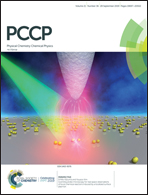Transition metal embedded C3N monolayers as promising catalysts for the hydrogen evolution reaction†
Abstract
Transition metal (TM) doped or TM, N co-doped carbon materials have attracted increasing attention as efficient catalysts for the hydrogen evolution reaction (HER), to replace Pt or reduce the usage of Pt. By using first-principles calculations, the TM-embedded C3N monolayer (TM@C3N) has been theoretically investigated for HER, for which eighteen TMs are selected from the 3d, 4d, and 5d rows. The M-CC catalysts, with the TM atom embedded into the C–C double atomic vacancy, are the most stable among the various TM@C3N materials. All the M-CC catalysts show metallic conductivity and high thermal stability. The hydrogen binding free energy for the M-CC catalysts can be optimized to be close to 0 eV by choosing a suitable TM, and the kinetic barrier under the Tafel mechanism for further gaseous hydrogen evolution can be reduced to as low as 0.58 eV. These results suggest that the HER catalytic activities of the M-CC catalysts are likely comparable or even higher than those of the well-explored MoS2 nanostructures or Pt catalysts. Moreover, the HER activities of the M-CC catalysts can be illustrated by the electronic state distribution near the Fermi level of the catalytically active sites. This study provides a new possibility for cost-efficient HER catalysts of high activity and for the application of C3N nanostructures.



 Please wait while we load your content...
Please wait while we load your content...